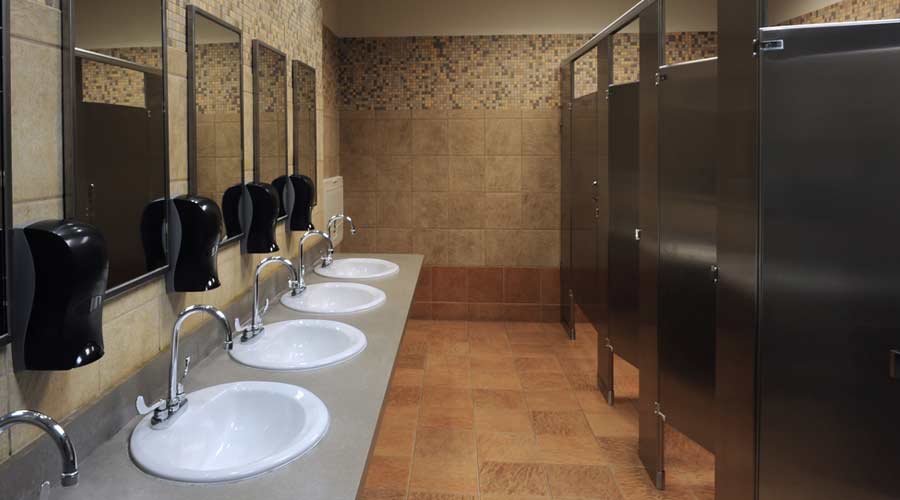
Amidst heightened awareness of hand hygiene and the proliferation of hand sanitizers, the shortcomings of bulk soap dispensers are increasingly difficult to ignore: These systems are a frequent breeding ground for bacteria, according to research studies, and a source of cross-contamination that places building occupants’ health and safety at risk.
Jeff Fein, owner of Sidhal Industries in Hempstead, New York, agrees wholeheartedly. He recommends sealed soap systems for every type of facility, and although the company still supplies customers with bulk soap options, he sells less and less of them every year.
“I truly believe that in the next few years, gallon soap will go the way of the dinosaur,” he says. “Today’s sealed cartridges are much more sanitary and avoid a lot of problems, like cross-contamination as well as bacteria and mold growing in the reservoirs.”
Fein is quick to point out that the issue is not with bulk soap per se, but with the dispenser itself: By design, the unit is susceptible to contaminants every time the lid is opened to refill the product. Research has confirmed and documented these findings, including well publicized studies by Dr. Charles Gerba, a microbiologist and professor at the University of Arizona in Tucson, who found fecal bacteria from the air in restrooms present in refillable soap dispensers.
How Clean is the Soap?
Perhaps one of the most significant concerns with bulk soap dispensers is the difficulty in cleaning and maintaining them — a task that is often neglected by custodians who are strapped for time. Indeed, bulk soap dispensers are seldom cleaned, and in truth most are never cleaned.
Paul Goldin, vice president of supply chain and asset management, Bee-Clean Building Maintenance, Manitoba, Canada, admits that building service contractors (BSCs) most likely do not give bulk soap dispensers the attention they deserve.
“If it’s going to be done properly, the reservoir should be thoroughly cleaned on a regular schedule, depending on the type of system in place,” he says. “In our world, that’s not realistic in terms of time management of a custodian in a building. It’s a wonderful theory, but that’s all.”
Darla Goeres, a research professor at the Center for Biofilm Engineering, Montana State University, Bozeman, Montana, shares this sentiment. She explains that in order to properly clean a bulk soap dispenser, it would have to be removed from the wall, drained of old soap, scrubbed, rinsed with warm water and left to air dry before re-hanging it and filling it with new soap.
“I’m not a betting woman, but I would be blown away if that’s a part of the regular maintenance for a lot of buildings,” she says. “Generally, when the soap is close to empty it is topped off.”
Goeres, who participated in a study on the evaluation and remediation of bulk soap dispensers for biofilm, says that this cycle — leaving dispensers in place for extended periods, not draining them completely and topping them off with new soap — is the primary cause of contamination.
After testing bulk soap dispensers, she found bacteria in the soap as well as biofilm attached to the inner dispenser surfaces. Experiments to clean the reservoirs showed that even highly concentrated disinfectants do not eliminate bacterial populations that adapt to the soap environment.
The issue of bacterial growth is further compounded when custodians top off dispensers with different types of soap.
“Typically, bulk soap has preservatives to dissuade bacteria from growing,” Goeres explains. “But when there’s one type of soap and another type is added on top of it, those two preservatives don’t always ‘play nice’ with each other; they negate each other.”
Similarly, diluting soap with water to make it last longer can be problematic.
“This has two consequences,” says Goeres. “One, drinking water contains bacteria, which have now been introduced to the soap; and two, the water dilutes the soap’s preservative, which makes it less effective.”
Unsanitary Sanitizers
In a post-pandemic era, hand sanitizer stations have become ubiquitous — as have the risks associated with using refillable dispensers. Like bulk soap systems, refillable sanitizer stations are subject to contamination that could increase the risk of infections rather than curb them.
According to Centers for Disease Control and Prevention (CDC) guidelines for hand hygiene in healthcare settings, soap should not be added to partially empty soap dispensers. The guidelines also address the refilling or topping off of alcohol-based hand sanitizer containers, stating that this practice could result in potential safety risks, including “inadvertent contamination, reduced effectiveness from the evaporation of alcohol and irritant effects from mixing formulations.”
During the height of the pandemic, the American Cleaning Institute (ACI), Washington, D.C., expressed its concerns to Food and Drug Association (FDA) about the flood of hand sanitizer products on the market. According to ACI, these products are often sold in bulk and then used to fill existing dispensers, some of which are not intended to be refilled. As is the case with bulk soap, this practice can result in the mixing of different products, which can render hand sanitizers ineffective.
The FDA has since withdrawn its guidance documents outlining temporary policies for manufacturers that were not drug manufacturers to produce certain alcohol-based hand sanitizers and alcohol for use in hand sanitizers. The agency mandated that these companies cease production of these products by Dec. 31, 2021.
Time and Labor Savings Result in Cleaner Restrooms

 The Down and Dirty on Cleaning in Virus Season
The Down and Dirty on Cleaning in Virus Season How Surfactant Use is Expanding in Commercial Cleaning
How Surfactant Use is Expanding in Commercial Cleaning